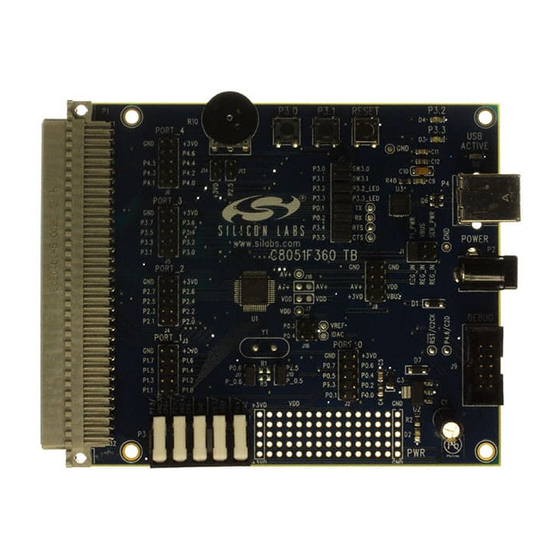
Table of Contents
Advertisement
Quick Links
C8051F36x D
1. Kit Contents
The C8051F36x Development Kit contains the following items:
• C8051F360 Target Board
• C8051Fxxx Development Kit Quick-start Guide
• Silicon Laboratories IDE and Product Information CD-ROM. CD content includes:
• Silicon Laboratories Integrated Development Environment (IDE)
• Keil 8051 Development Tools (macro assembler, linker, evaluation 'C' compiler)
• Source code examples and register definition files
• Documentation
• C8051F36x Development Kit User's Guide (this document)
• AC/DC Power Adapter
• USB Debug Adapter (USB to Debug Interface)
• USB Cable
2. Hardware Setup using a USB Debug Adapter
The target board is connected to a PC running the Silicon Laboratories IDE via the USB Debug Adapter as shown
in Figure 1.
1. Connect the USB Debug Adapter to the DEBUG connector on the target board with the 10-pin ribbon cable.
2. Connect one end of the USB cable to the USB connector on the USB Debug Adapter.
3. Connect the other end of the USB cable to a USB Port on the PC.
4. Connect the AC/DC Power Adapter to power jack P2 on the target board.
Notes:
• Use the Reset button in the IDE to reset the target when connected using a USB Debug Adapter.
• Remove power from the target board before removing the ribbon cable from the target board. Connecting or
disconnecting the cable when the devices have power can damage the device and/or the USB Debug
Adapter.
R10
P1
PORT_4
J14
J13
J6
PORT_3
SILICON LABS
www.silabs.com
J5
PORT_2
F360
U1
J4
PORT_1
J11
J3
P3
Target Board
Figure 1. Hardware Setup using a USB Debug Adapter
Rev. 0.1 12/06
E V E L O P M E N T
P3.0
P3.1
RESET
D4
USB
ACTIVE
D3
J12
D5
P3.0
SW3.0
P3.1
SW3.1
P4
U3
P3.2
P3.2_LED
P3.3
P3.3_LED
P0.1
TX
P0.2
RX
P3.4
RTS
POWER
P3.5
CTS
P2
J1
C8051F360 TB
J8
J15
DEBUG
PORT_0
J16
J9
J10
J2
Copyright © 2006 by Silicon Laboratories
C 8 0 5 1 F 3 6 x - D K
K
U
'
G
I T
S E R
S
AC/DC
Adapter
USB Debug Adapter
U I D E
USB
Cable
C8051F36x-DK
PC
Advertisement
Table of Contents

Summary of Contents for Silicon Laboratories C8051F360x-DK
- Page 1 • USB Cable 2. Hardware Setup using a USB Debug Adapter The target board is connected to a PC running the Silicon Laboratories IDE via the USB Debug Adapter as shown in Figure 1. 1. Connect the USB Debug Adapter to the DEBUG connector on the target board with the 10-pin ribbon cable.
-
Page 2: Software Setup
Keil 8051 tools at the command line (e.g. batch file or make file) or by using the project manager built into the IDE. The default configuration when using the Silicon Laboratories IDE project manager enables object extension and debug record generation. Refer to Application Note “AN104: Integrating... - Page 3 ROM for additional information on using the Keil 8051 tools with the Silicon Laboratories IDE. To build an absolute object file using the Silicon Laboratories IDE project manager, you must first create a project. A project consists of a set of files, IDE configuration, debug views, and a target build configuration (list of files and tool configurations used as input to the assembler, compiler, and linker when building an output object file).
-
Page 4: Example Source Code
C8051F36x-DK 5. Example Source Code Example source code and register definition files are provided in the “SiLabs\MCU\Examples\C8051F36x” directory during IDE installation. These files may be used as a template for code development. Example applications include a blinking LED example which configures the green LED on the target board to blink at a fixed rate. -
Page 5: Target Board
C8051F36x-DK 6. Target Board The C8051F36x Development Kit includes a target board with a C8051F360 device pre-installed for evaluation and preliminary software development. Numerous input/output (I/O) connections are provided to facilitate prototyping using the target board. Refer to Figure 2 for the locations of the various I/O connectors. 96-pin female connector Power connector (accepts input from 7 to 15 VDC unregulated power adapter) Analog I/O terminal block... -
Page 6: Switches And Leds
C8051F36x-DK 6.1. System Clock Sources The C8051F360 device installed on the target board features a calibrated programmable internal oscillator which is enabled as the system clock source on reset. After reset, the internal oscillator operates at a frequency of 3.0625 MHz (±1.5%) by default but may be configured by software to operate at other frequencies. Therefore, in many applications an external oscillator is not required. - Page 7 C8051F36x-DK 6.3. PORT I/O Connectors (J2 - J6) In addition to all port I/O signals being routed to the 96-pin expansion connector, each of the five parallel ports of the C8051F360 has its own 10-pin header connector. Each connector provides a pin for the corresponding port pins 0–7, +3.3 VDC and digital ground.
-
Page 8: Power Connector (J1)
6.5. USB to Serial Connector (P1) A USB-to-Serial bridge interface is provided. A USB B-type connector (P1), a Silicon Laboratories CP2102 USB-to- UART Bridge, and related circuits are provided to facilitate the serial connection between a PC and the C8051F360 microcontroller on the target board. - Page 9 C8051F36x-DK 7. Schematics Rev. 0.1...
- Page 10 C8051F36x-DK Rev. 0.1...
- Page 11 C8051F36x-DK OTES Rev. 0.1...
-
Page 12: Contact Information
Silicon Laboratories products are not designed, intended, or authorized for use in applications intended to support or sustain life, or for any other application in which the failure of the Silicon Laboratories product could create a situation where per- sonal injury or death may occur.

Need help?
Do you have a question about the C8051F360x-DK and is the answer not in the manual?
Questions and answers